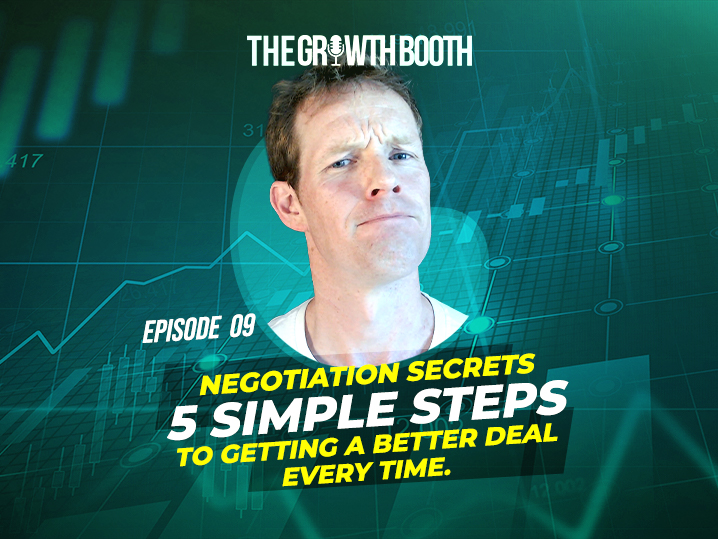 Negotiation is a part of daily life. You negotiate with your partner, your kids, your friends and colleagues. A lot of the time, you aren’t even aware of it. Negotiating doesn’t necessarily involve the exchange of goods. Also, it’s not always about getting the best value for the money.
Negotiation is a part of daily life. You negotiate with your partner, your kids, your friends and colleagues. A lot of the time, you aren’t even aware of it. Negotiating doesn’t necessarily involve the exchange of goods. Also, it’s not always about getting the best value for the money.
Look back into your past, and you’ll realize that you’ve been negotiating even when you were young. For example, you probably swapped toys with your friend when playing, or maybe even traded your lunch with a schoolmate in elementary school.
It was sometimes not a one-for-one deal, though. Maybe you asked for an add-on, especially if you thought your food was worth more than what was being offered in return.
For instance, a BLT isn’t necessarily equal to a bologna sandwich. It’s you and your schoolmate that determines what each is worth. If your counterpart wanted your BLT more than you desired a bologna sandwich, you probably asked for a chocolate chip cookie or something else to seal the deal.
Eventually, you would have both reached an agreement and parted ways, both feeling satisfied.
In this post, we’ll share advice on being successful at negotiations. Maybe you already know a few of them. By practicing these essential tips, you’ll improve your skills as a negotiator. But, first, let me clear up a few things, the most important being…
Negotiating is NOT a competition.
“Play hardball. If you don’t, then you lose.” That’s the first thing most people have in mind before entering into any negotiation. But, unfortunately, you will never become a successful negotiator if you keep up this attitude.

In business, you both want to leave the proverbial negotiating table a winner. This becomes easy if you find a win-win solution. In short, no one has to leave as a loser. Of course, there will be times you have to walk away and consider other options. The trick is to know when.
Think of your counterpart as a possible business partner and not an enemy. As a seller or buyer, you want to create lasting relationships. The key is finding the right terms that will leave everyone feeling they’ve won rather than lost.
The exception is when greed becomes a factor. This is a reality with monopolies, which can dictate the terms. I’m sure you’ve encountered that supplier who knows you have no other place to go. Again, though, this doesn’t mean you give in without a fight.
Second, negotiation is NOT a negative thing.
Negotiating doesn’t mean taking advantage of another person. Yes, people can become anxious because they believe their counterparts will misrepresent, lie or exaggerate. Or, they fear that they will be sweet-talked into agreeing to unfavorable terms.
Sure, voices can be raised and conflicts arise during negotiations. The trick is not to be swayed by emotion. A good negotiation means both parties leave feeling satisfied.
Keep in mind that there’s no harm in asking for something better. The worst that can happen is you’ll end up in the same position you started from.
Now on to our secrets.
Don’t use round numbers
When you shop on Amazon, you’ll notice that prices are rarely whole numbers. There’s a reason behind this. If an item is $50 while a competitor’s brand is $49.97, guess which product is getting a closer look? It’s the latter.
Also known as charm pricing, sellers use this strategy, especially when it’s hard to see the differences between competing products. They use the left-digit bias, a phenomenon when consumers are influenced by the left-most digit of prices.
A non-round number makes the seller think that you’ve done your homework. For instance, if you’re running a Print On Demand business, a few cents will matter if you often order from your supplier or buy items in bulk.
For example, your initial offer could be $1.34 per unit instead of $1.35 or even $1.40. The supplier counters with $1.60, which is considerable when hundred or even thousands of dollars are at stake. Somewhere in between is the price both of you will agree on.
If you know the price you are willing to pay, or if you want to be perceived as knowing the price you will pay to still make a good profit on your product, the negotiating number will not be a whole number.

Be Prepared
Before you get into any negotiation, make preparations. Of course, there are many unforeseeable situations, such as your child asking for more time playing a computer game. Some parents would outright say no. But, others would agree for something in return.
If you’re a parent, you can’t anticipate what your child will ask for, but you should have ideas on hand the next time your child makes a request. For instance, a little but of extra time IF they clean their room first.
The same is true in business.
Being prepared gives you a better position in negotiations. With enough leverage, you can deal from a place of strength.
This means knowing the maximum amount you’ll spend or the lowest price you can agree to. Also, while preparing, think of the extras and “tradables” you can offer that won’t affect your bottom line.
For instance, if you are selling web design services for a client, a tradable that can seal the deal could be an extra year of free web hosting, or a free domain name. It won’t cost you much, and your client will be satisfied with the extra deals they are getting.
If you a buyer, you can do the same thing. Say you are looking for a new car. You do your research, and you know that the model you want doesn’t come with a sunroof. When negotiating for the new vehicle, ask for the sunroof option. When the salesperson says that it doesn’t come with one, you are now in a position to do your own tradable.
For example, you can say “All right, well, I really wanted one, but if it doesn’t come with it, could you offer me this deal instead, then?” They will then be more likely to give you some sort of tradable that you really wanted, such as tinted windows or remote start.
Lastly, preparation includes researching the people or the organization you’ll be dealing with. You can gain some great insights on what they are yearning for, which will help you find that win-win solution. If the client has never had a web site, then they likely don’t have a domain. Throw in a great sounding domain name for them for free.
Listen to What’s Really Important
Imagine your counterpart is discussing why the current terms are unacceptable. Your first impulse is to be defensive. But, if you listen carefully instead of mentally preparing your rebuttal, you’ll discover what’s really important.
Keeping silent also gives time for your counterpart to calm down after becoming emotional. I remember a client being angry after our company increased prices by 10%. Instead of justifying, I asked questions.
I found out that price wasn’t actually the underlying issue. Our client didn’t want to leave without something in return. Because I was prepared, I offered an extended warranty and a bigger discount if more of our products were purchased.
A little bit of empathy helps. Placing yourself in the shoes of a buyer or seller gives you a greater perspective. Place emphasis on “a little bit,” by the way. Keep in mind you’re after making a profit too.

Try to agree in the middle of negotiations.
Sometimes, you might both agree to an offer right away. However, if this doesn’t happen, as the seller, offer a price that is higher than what you are expecting. Conversely, as a buyer, offer a price lower than what you’re actually willing to pay.
For example, you’re buying plain t-shirts for your business. Depending on the brand and material, these can cost anywhere from $2.25 to $4.00. Open up with 75% of what you’re willing to pay. If this is rejected, increase your price in small increments.
Don’t fret if your counterpart’s final offer is above your maximum amount. Instead, ask for extras, like free or faster shipping.
Many suppliers have set wholesale prices. In some cases, though, you get a fixed price regardless of how many t-shirts you buy. In either case, it doesn’t mean you should negotiate on price alone.
After some haggling, set a final price and terms. As the seller, there’s always a polite way to refuse further concessions. However, give your counterpart alternatives. For instance, Option 1 will cost this and include this benefit. Option 2 will be cheaper but without this benefit.
Avoid the nibbles when you can
It’s a done deal. As the seller or salesperson, you’ve just shaken hands and begun to part ways. But then, you hear, “By the way, one more thing.” This can be a small request or a significant element you wished you knew beforehand.
Professional negotiators wait until the end before bringing up these nibbles. But, you can pre-empt a curve ball thrown at you.
All you need to do is ask if there are other factors your counterpart needs to bring up before you give or offer a final price. Is there anything else you need to know before you sign the deal?
If there is none, review the terms you’ve discussed to be clear nothing is left out. Then close the door to any nibbles before you make an agreement.
Avoiding the nibbles also means reading the fine print. Unfortunately, many customers and buyers fail to read those little details before purchasing.
Plan ahead.
Anticipate issues that might come up before you negotiate. Again, do your research. Check the prices of competitors and the possible concerns of your counterparts. Think about what your approach should be to them.
Also, know your walk-away point. But always plan to create a mutually beneficial relationship. This is your first priority.
We hope some of these tips will help you become a better negotiator. Try them out, and you’ll be surprised at how far you can go in your deals!
For a more in-depth interview on negotiating, please watch my recent episode of The Growth Booth, where I interview Chris Croft, one of the world’s leading trainers on negotiating and sales.
You can also download the complete transcription from this episode:
or, click here to a listen to the full show.
For these and upcoming podcasts visit Thegrowthbooth.com where we talk about online business, mindset, and lifestyle freedom.
Episodes are released every Tuesday on these popular channels:







I love the “avoid the nibbles”. I offer website services, and my clients always ask for extra things. I’ll have to be more firm and make sure to ask if they need anything else first before signing a contract. Thanks for the tips!
Yes, and make sure you have “tradables” to seal the deal, like a free domain name, hosting for a year, stuff like that. Thanks for reading!
I always have this problem when shopping for a new car. I’ll have to try some of these tactics next time, such as asking for features that I know they don’t have and I don’t really want, just to see what extras they come up with!